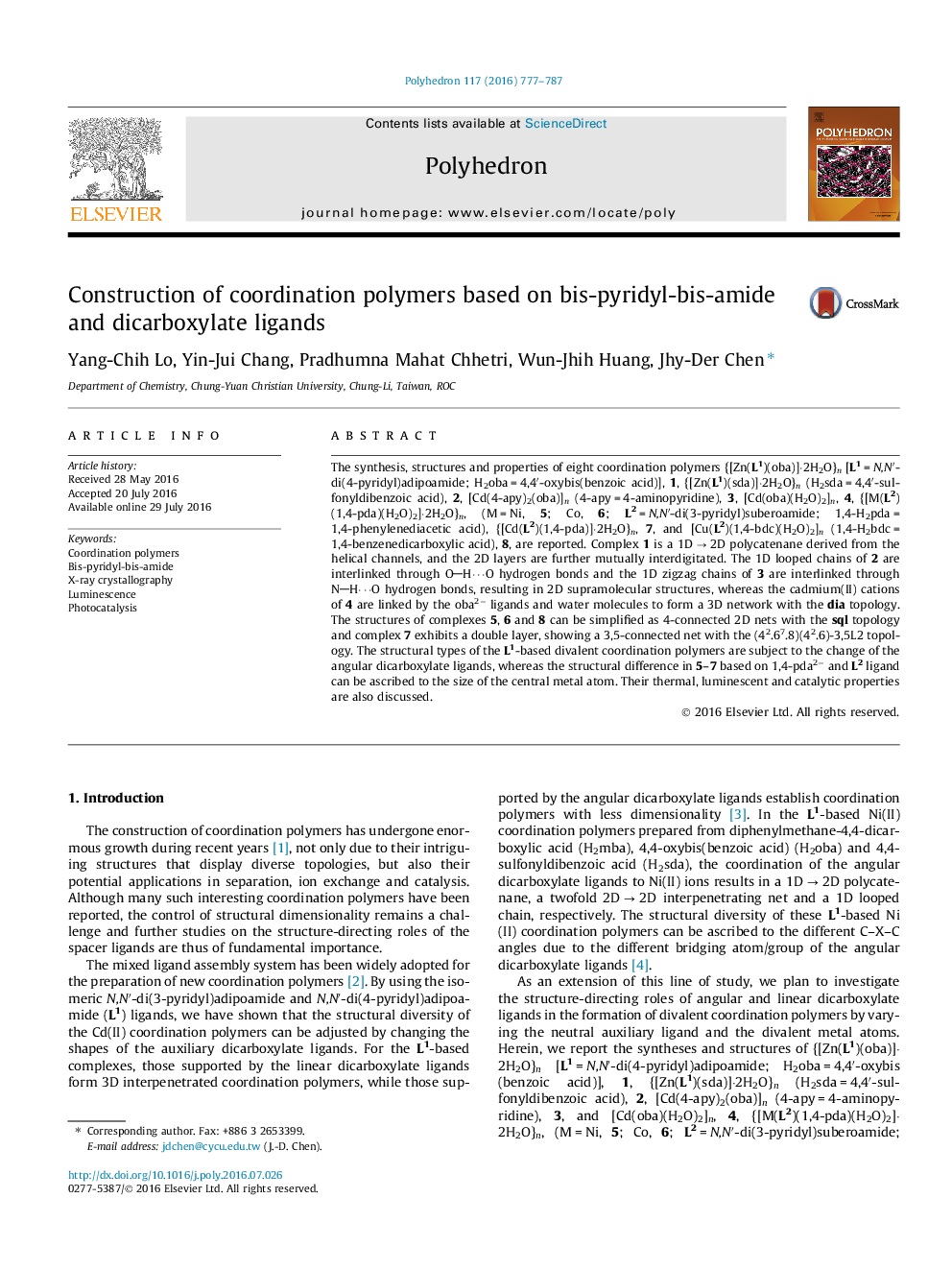| کد مقاله | کد نشریه | سال انتشار | مقاله انگلیسی | نسخه تمام متن |
|---|---|---|---|---|
| 1336268 | 1500223 | 2016 | 11 صفحه PDF | دانلود رایگان |
The synthesis, structures and properties of eight coordination polymers {[Zn(L1)(oba)]·2H2O}n [L1 = N,N′-di(4-pyridyl)adipoamide; H2oba = 4,4′-oxybis(benzoic acid)], 1, {[Zn(L1)(sda)]·2H2O}n (H2sda = 4,4′-sulfonyldibenzoic acid), 2, [Cd(4-apy)2(oba)]n (4-apy = 4-aminopyridine), 3, [Cd(oba)(H2O)2]n, 4, {[M(L2)(1,4-pda)(H2O)2]·2H2O}n, (M = Ni, 5; Co, 6; L2 = N,N′-di(3-pyridyl)suberoamide; 1,4-H2pda = 1,4-phenylenediacetic acid), {[Cd(L2)(1,4-pda)]·2H2O}n, 7, and [Cu(L2)(1,4-bdc)(H2O)2]n (1,4-H2bdc = 1,4-benzenedicarboxylic acid), 8, are reported. Complex 1 is a 1D → 2D polycatenane derived from the helical channels, and the 2D layers are further mutually interdigitated. The 1D looped chains of 2 are interlinked through OH⋯O hydrogen bonds and the 1D zigzag chains of 3 are interlinked through NH⋯O hydrogen bonds, resulting in 2D supramolecular structures, whereas the cadmium(II) cations of 4 are linked by the oba2− ligands and water molecules to form a 3D network with the dia topology. The structures of complexes 5, 6 and 8 can be simplified as 4-connected 2D nets with the sql topology and complex 7 exhibits a double layer, showing a 3,5-connected net with the (42.67.8)(42.6)-3,5L2 topology. The structural types of the L1-based divalent coordination polymers are subject to the change of the angular dicarboxylate ligands, whereas the structural difference in 5–7 based on 1,4-pda2− and L2 ligand can be ascribed to the size of the central metal atom. Their thermal, luminescent and catalytic properties are also discussed.
Graphical AbstractEight coordination polymers {[Zn(L1)(oba)]·2H2O}∞ [L1 = N,N′-di(4-pyridyl)adipoamide; H2oba = 4,4′-oxybis(benzoic acid)], 1, {[Zn(L1)(sda)]·2H2O}∞ (H2sda = 4,4′-sulfonyldibenzoic acid), 2, [Cd(4-apy)2(oba)]n (4-apy = 4-aminopyridine), 3, [Cd(oba)(H2O)2]n, 4, {[M(L2)(1,4-pda)(H2O)2]·2H2O}n, (M = Ni, 5; Co, 6; L2 = N,N′-di(3-pyridyl)suberoamide; 1,4-H2pda = 1,4-phenylenediacetic acid), {[Cd(L2)(1,4-pda)]·2H2O}n, 7, and [Cu(L2)(1,4-bdc)(H2O)2]n (1,4-H2bdc = 1,4-benzenedicarboxylic acid), 8, are reported. The structural types of the L1-based divalent coordination polymers are subject to the change of the angular dicarboxylate ligands, whereas the structural difference in 5–7 based on pda2− and L2 ligand can be ascribed to the size of the central metal atom. Their thermal, luminescent and catalytic properties are also discussed.Figure optionsDownload as PowerPoint slide
Journal: Polyhedron - Volume 117, 15 October 2016, Pages 777–787
